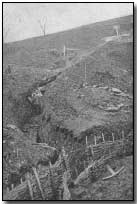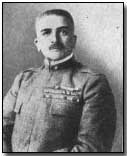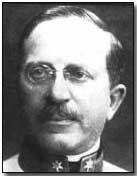Battles - The Battle of the Piave River, 1918
 The Battle of the Piave River comprised the last major Austro-Hungarian attack on the Italian Front
and virtually heralded the disintegration of the Austro-Hungarian army on
the way to the dismantling of the empire.
The Battle of the Piave River comprised the last major Austro-Hungarian attack on the Italian Front
and virtually heralded the disintegration of the Austro-Hungarian army on
the way to the dismantling of the empire.
The main assault, fought between 15-22 June 1918, was prompted by German demands upon their ally to launch an offensive across the Piave river - which was situated a bare few kilometres from key Italian cities such as Venice, Padua and Verona - now that the Russians had withdrawn from the war. It was also intended as a belated follow-up to the spectacularly successful combined German/Austro-Hungarian offensive at Caporetto the previous autumn.
However the Austro-Hungarian of June 1918 was quite different from the one that had triumphed at Caporetto eight months earlier. It was demoralised, equipment and other supplies were perilously low, and while apparently demonstrating superior numbers of divisions to their Italian counterparts individual unit strengths were notably weakened.
At the same time the Italian army had been the beneficiary of burgeoning Allied war munitions production. Furthermore, incoming Chief of Staff Armando Diaz had taken care to deploy adequate defences along the Piave.
 However
both Austro-Hungarian commanders on the spot -
Boroevic
and former Commander-in-Chief
Conrad
- were in favour of an attack along the Piave (Conrad much more so than
Boroevic), although both (in a state of
unhelpful rivalry) demanded significant reinforcements before an attack
could commence.
However
both Austro-Hungarian commanders on the spot -
Boroevic
and former Commander-in-Chief
Conrad
- were in favour of an attack along the Piave (Conrad much more so than
Boroevic), although both (in a state of
unhelpful rivalry) demanded significant reinforcements before an attack
could commence.
This led to newly-installed Chief of Staff Arz von Straussenberg's decision to split forces equally between the two commanders, 58 divisions in total (against 57 Italian).
Although the Austro-Hungarians intended to advance in a pincer movement Straussenberg's decision to divide his forces meant that neither commander had sufficient strength in depth to achieve a knock-out blow. Straussenberg determined to open the attack with a direct assault on the river by Boroevic's forces, to be followed with an attack in the Trentino by Conrad.
Thus Boroevic opened the offensive with his Fifth and Sixth Armies on 10 June, crossing the Piave along the coast. His forces had advanced several kilometres in the face of heavy Italian counter-attacks before he was obliged to beat a retreat on 19 June.
 However,
re-crossing the rapids of the Piave proved problematic and enabled the
Italians to attack Boroevic in the flank. By the time Boroevic had
successfully re-crossed the river on 22 June his forces had suffered some
150,000 casualties.
However,
re-crossing the rapids of the Piave proved problematic and enabled the
Italians to attack Boroevic in the flank. By the time Boroevic had
successfully re-crossed the river on 22 June his forces had suffered some
150,000 casualties.
Meanwhile Conrad's attacks along the Trentino from 15 June by his Tenth and Eleventh Armies, intended at the capture of Verona, proved of little effectiveness. Faced with strong counter-attacks by the Italian Fourth and Sixth Armies (which included British and French troops) the Austro-Hungarians suffered 40,000 casualties within a week.
The comprehensive failure of the offensive served merely to hasten the disintegration of the Austro-Hungarian army, which effectively ceased to exist as a single cohesive force. Its dismantling was finalised by the Italians at the Battle of Vittorio Veneto in the autumn.
Click here to view a map of the battle of the Piave.
Click here to read Conrad's official address given as encouragement to his forces on the eve of the battle. Click here to read the official French observer's report on the course of the battle. Click here to read the report written by the official German observer, Max Osborn. Click here to read an account of the battle given by G.M. Trevelyan, head of the British Red Cross in Italy. Click here to read the report by the commander of British forces in Italy, Earl Cavan.
Photographs courtesy of Photos of the Great War website
"Drum Fire" was an artillery barrage fired not in salvo but by each gun in succession.
- Did you know?
